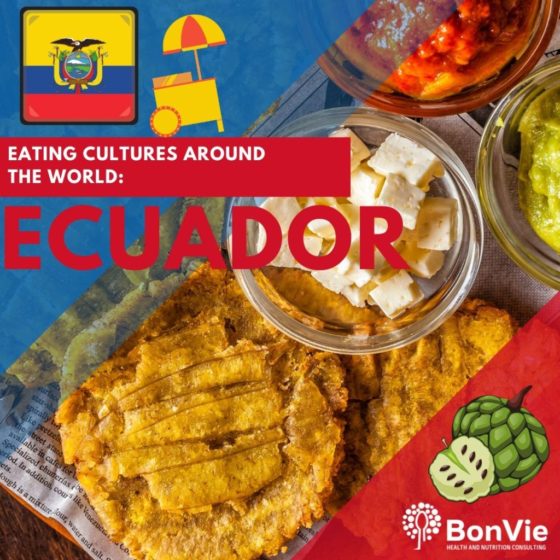
25 Jan Eating Cultures Around the World: Ecuador
I confess that I know little about Ecuadorian culture, though I fantasize about how incredible the country is – one single country that has both Amazon jungles and the Galapagos Islands? Are you kidding me? How cool is that?! Those varying climates make for awesome food!
The diet in Ecuador relies mainly on elevating whole, nutritious, home-grown foods. Different regions of Ecuador (city, coastal, mountainous) vary slightly in terms of the foods they offer. Coastal regions offer more fish, while cities usually have more sophisticated Ecuadorian or international cuisines. Mountainous regions rely heavily on potatoes, quinoa, beans and corn, since other crops have difficulty growing at higher altitudes. Since the climate in Ecuador is so diverse from region to region, Ecuador is able to produce most of their own crops. That means that their food is super nutritious and accessible!
If you’re into Spanish food and culture, then Ecuador is right up your alley – they have some serious Spanish influence over there, including with their cuisine. What’s distinct about Ecuador is how they take that Spanish flavor and apply it to their own native plants and animals to make them the star of the dish. Native plants such as guava, mango, blackberries, strawberries, papaya, potatoes, quinoa, beans, yuca, tomatoes, peppers, corn, peanuts, squash, chocolate, vanilla and avocados are commonly consumed and influence many Ecuadorian classic dishes. Birds, rabbits, deer, guinea pig, and fish are commonly consumed meat sources.
Ecuadorians usually eat 3 square meals a day, with breakfast being anywhere from 6:30 to 9:00 AM. Typical breakfast staples include scrambled eggs, pancakes, rice and potatoes. Native fruits, toast, corn tortillas and coffee are also common breakfast staples. Sometimes a morning snack is enjoyed, which usually consists of dishes like empanadas, tamales, sandwiches or even hamburgers.
Lunch is typically enjoyed around 12:00 to 2:00PM and is usually the largest meal of the day. Ecuadorian classics such as soups, chicken, pork, cuy (roasted guinea pig), shrimp, lobster, fish, potatoes, beans, corn, rice or quinoa, plantains, yuca, and fresh fruits are commonly served.
Dinner is usually served around 10:00 PM – super late by most American standards – and includes similar food items as lunch, but is typically a much smaller portion size.
Common Ecuadorian desserts include Bien me sabe (a coconut based dessert), flan, or tres leches (milk) cake.
You might be asking yourself how the heck Ecuadorians can eat so much (and so late) and still have a handle on the rising obesity epidemic across the globe?! Their food labeling standards are pretty impressive and they make it super simple for people to understand!
Currently, all pre-packaged and processed foods sold in Ecuador must use the traffic-light food label. The label takes into account the amount of salt, sugar and fat in a certain food item and creates a traffic light label to reflect these additives respective amounts. The label displays 3 categories: red (high amount), yellow (medium amount) and green (low amount). Since the law’s implementation, consumption and purchasing patterns of high fat food items and sugary beverages have decreased.
These kinds of food labels have been proven in many studies to be effective for improving nutrition intake in adults and children alike. So, the next time you’re reaching for a treat, take a cue from Ecuador and the traffic light guidelines – they really work!


Claudine Newton
Posted at 13:20h, 15 JanuaryHi,
What if the right media coverage could elevate your business to new heights?
At Global Wide PR, our goal is to enhance credibility and draw in new customers for businesses via features on leading media platforms.
To give you a taste of what’s possible, we’re offering a free article on Digital Journal—a straightforward method to improve your brand’s image and exposure.
If you’re looking to expand your reach even further, we offer placements on leading platforms like Yahoo Finance, Market Watch, and AP News.
If this sounds appealing to you, simply respond with “”FREEPR”” and I’ll send you more information.
Regards,
Claudine
Global Wide PR
Should you decide to unsubscribe from our updates, we’ve streamlined the process. Head to https://bit.ly/form-unsubscribe and enter your website details.
Patrick Carter
Posted at 12:41h, 28 JanuaryHi,
Running a business is full of opportunities and challenges, and having the right resources at the right time can make all the difference. Whether you’re preparing for growth, managing seasonal expenses, or responding to an unexpected need, having access to flexible funding options can help you stay ahead.
Our funding solutions are designed to meet the unique needs of businesses like yours. We focus on fast approvals, straightforward processes, and flexibility to ensure you have the support you need when you need it.
Here’s how we can help:
Funding amounts tailored to your goals, with quick approvals to keep your momentum going.
Options for working capital, equipment purchases, expansion projects, or simply strengthening cash flow.
No complicated requirements—just solutions designed with businesses in mind.
We understand that timing is everything, and even if funding isn’t on your radar right now, it’s always a good idea to know your options. Consider saving this message for when the time is right—you never know when having quick access to funding might be exactly what you need to move forward.
If you’d like to learn more or explore the options available to you, feel free to reach out or visit our website anytime. We’re here to help support your business’s success.
Best regards,
https://bit.ly/funding202501
If at any point you don’t want to receive updates from us, please reply to this communication and include “No Thank You”.
Viale Augusto 128, Coxsackie, NY, USA, 73010
Claudine Caldwell
Posted at 23:44h, 21 MarchHi,
Your brand deserves to stand out, and we’re here to help.
At Global Wide PR, we specialize in connecting businesses with top media platforms to increase visibility and credibility. As a gesture to get started, we’re offering a free article on Digital Journal—a great way to showcase your business to a wider audience.
For those looking to maximize exposure, we can also feature your brand on affiliates of FOX, NBC, CBS, ABC, and 300+ other sites for just $297. These placements can help you build trust and attract new customers.
To take advantage of this opportunity, click the link below to sign up on our site, and we’ll get back to you ASAP:
https://bit.ly/globalwidpr
Looking forward to helping your brand shine!
Best regards,
Claudine
Global Wide PR
We value your preferences and understand that you might prefer not to receive our updates. To opt out of our emails, please complete the unsubscribe form with your website address: bit. ly/unsubscribemeurl